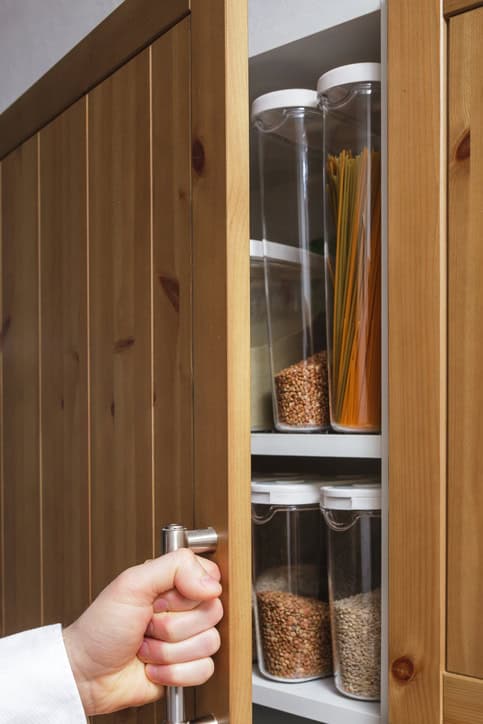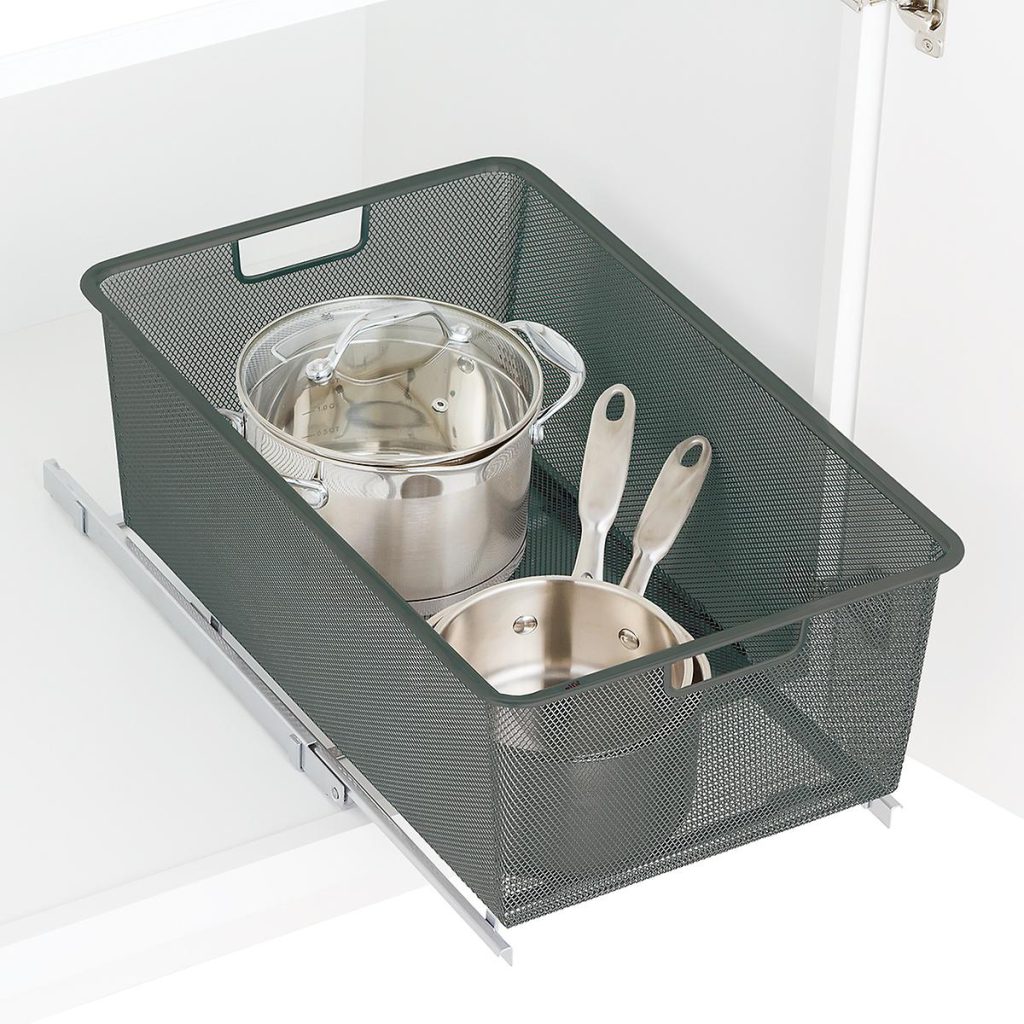
The pantry is one of the places in the home that quickly becomes messy and disorganized. It’s so easy, if you’re in a rush, to just stash the non-perishable items on the pantry shelves when emptying the grocery bags. Instead, take the time to methodically put the non-perishable pantry items where they belong. When you take the time to maintain the organization in your pantry it doesn’t become messy and disorganized. Use these 5 tips to organize your pantry and then maintain the organization so that you save money on food and time on meal preparation.
Everyone has a pantry in their home. Some have a small pantry cupboard in their kitchen with a larger pantry somewhere else in their house like the basement or garage. Others have a larger pantry section of shelves or even a large walk-in pantry closet in their kitchen. Whatever the size of your pantry and wherever it is in your home it must work for you because its purpose is to keep basic non-perishable supplies on hand.
1. Grocery shelves
Group like items together as you would find them in the grocery store.
Put canned goods together by category: soups together, fruits, tomato paste and sauce, you get the idea. Put the newer cans to the back of the shelf with the older ones in the front so that things do not expire on you.
Keep baking goods together on a separate shelf or in a separate section.
Have a section or shelf for unopened condiments.
Breakfast cereals and foods get their own section or shelf.
Snacks like chips, granola bars, and cookies need their section, too.
Drinks like bottled water and soda belong together.
If you have a pet or several pets, their food and treats gets a section or shelf also.
2. Food storage
Now that you know to group your food into categories, the next step is to think about how you will store it.
Leave canned food in the cans. If you have lots of canned food and they are hard to see, consider investing in shelf risers. They are easy to find in stores that carry housewares.
Remove dry foods like flour, sugar, cereal, and crackers from their original packaging and store these items in clear canisters. This protects the food from moist air and bugs. It also lets you see how much you have so you know when to buy more.
Organize your pantry shelves with square canisters or containers. These work best because they fit well together. They come in a variety of sizes. Small ones stack easily. Round containers take up more space. If you have lots of space, don’t worry about it. If you have limited space, make the most of your available space by using square containers.
Check the containers at the store before you buy them to see how easy they are to open and close. Also, check to see how well they seal when they are closed. These are important things to consider since food stays fresh longer if moist air is kept out.
Keep small foods like individual bags of chips or granola bars in a basket. Set the basket at a height so that it is easy to grab individual snacks and go for everyone in the family.
If your shelves are very deep, consider installing pull out drawers like these from The Container Store or keeping things in bins that are easy to lift off the shelf.

Heavy containers, like big containers of dog food, are best kept down near the floor.
Small appliances that you use less often are best kept up on a high shelf and out of the way.
3. Use labels
Label the containers so that everyone in the family knows what’s inside the container. The label doesn’t have to be fancy or difficult to make. It can simply be the name of the food ‘Sugar’ on a piece of paper and taped to the container. Do what works for you.
Organize your pantry with labels on the shelves.
This way you won’t forget which section is for each category of food. It also makes it easy for your family to help putting away the groceries and to find what they are looking for.
When you are labeling take a minute to label the canned food with the date you brought it into the house. This will help you to use the oldest canned food first.
Another food group to label is your spices. Spices are expensive and you only use a tiny little bit at a time. They lose their flavor after a time and will not add anything to your recipe. Keep track of their age by marking the date you purchased the spice on the bag or jar.
4. Avoid the BOGO trap
It is easy to rationalize buying more than you need at any given time when the sign at the grocery store says, ‘Buy One Get One Free’. You think to yourself that you are saving money – which you are but what are you giving up?
Are you giving up valuable shelf space to store the extra foods you are buying? If you have the space in your home, then there is no problem.
If you have a small home with a small pantry is it worth using the space to save a little bit of money? Will you plan to use this extra food soon? These are questions for you to answer for yourself.
5. Shop from your pantry
When you are thinking about making a recipe, figure out the ingredients you need to use, then check your pantry before you make your shopping list. Many times, you have the extra tomato paste or the can of chicken stock sitting there on the shelf just waiting to be used.
Don’t spend money needlessly.
When your pantry is organized you will know exactly where to look to see if you have what you need for that recipe.
When you take the time to organize your pantry and keep it that way, you’ll find that you can easily make nutritious and delicious meals because you have the necessary ingredients at your fingertips!
If having an organized pantry is on your wish list of projects to tackle think about joining the Clear Space for You virtual support group. Jonda Beattie and I will guide you as you take the steps necessary to organize your pantry.
Click here to read more of my tips for getting organized.
Diane N. Quintana is a Certified Professional Organizer® owner of DNQ Solutions, LLC and co-owner of Release, Repurpose, Reorganize in Atlanta, Georgia. Diane specializes in residential and home-office organizing and working with people affected by ADD, hoarding challenges, and chronic disorganization. Diane has recently co-authored a book with Jonda Beattie titled: Filled Up and Overflowing. Please contact Diane for a free 30-minute phone consultation.


Such smart pantry advice, Diane — this is why you know how to train people to be grownups. That’s especially wise advice to put new canned and packaged food behind the existing cans, so you’re always eating what would expire first. (I do the same with milk and juice in the fridge, but I admit I get lazy about other fridge-residing items.) I should also admit I’ve never decanted cereal or crackers as you advise, but I finish off those two items such that there’s weekly turnover.
Do you prefer a specific canister brand? I am slowly moving from Rubbermaid to Oxo because they feel more senior-proof.
Great tips. The pantry is one of my favorite spaces to organize. It’s usually a small enough space that it can be done in not a lot of time and most decisions are clearly defined by using expiration dates as a guide.
These are excellent tips for keeping a pantry organized and useful. We have a tiny pantry, but I have organized HUGE pantries in my clients’ homes. Sometimes the big pantries become problematic because they store so much that supplies can spoil before use. Or things get lost behind the deep cubbies and shelves. Using labels, bins, baskets, and containers…and editing and releasing the items never used can help make any size space work most efficiently. One of the things I do is rotate the items. So the oldest cans or items are in the front, and the newest ones are behind. That way, we have a better chance of using the products before they expire.
I always like to organize a pantry. To me it’s kind of fun. It’s one of the easier organizing projects.
You have so many terrific ideas here. I love the one about shopping your pantry. It’s so true. You might think you have nothing to eat or you don’t have the ingredients you need for a dish. Rather than buying extra, that may just sit around, yep, shop your pantry first.
Pull out bins are awesome in a small pantry. They work great in shallow cabinet pantries. Thanks for sharing your pantry tips.
These are very practical, easy to follow tips Diane. Wonderful. I’ll pin it to my kitchen organizing board. I am looking to make my pantry look a bit nice. It is organized, but has some old containers and I’m starting to get envious of what I do for clients:). I love the tip about testing containers to see how easy they are to open before buying. Also, consider adding more shelves. Sometimes a very shallow shelf is just what you need to store large trays.